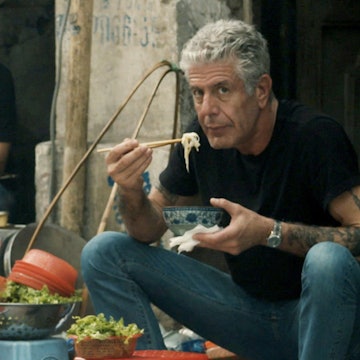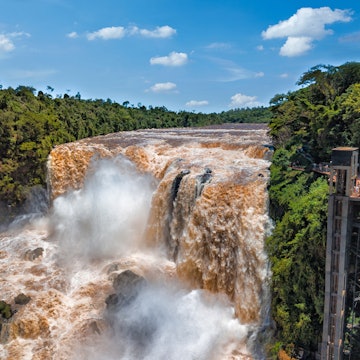

South America is home to some of the world's largest Pride parades © Victor Moriyama / Getty Images
South America knows how to throw a party, and when it comes to gay pride, the region puts some of the biggest celebrations in the world, drawing activists and revelers from around the globe to celebrate the LGBTQ+ community in living color. The festivities easily rival those in North America and West Europe, and they will pull you in with their kaleidoscopic energy and messages of love and acceptance.

Although most countries in South America have very conservative attitudes about homosexuality, largely due to the strong influence of the Catholic Church, most have developed quite progressive LGBTQ friendly laws, and have gay pride events taking place each year.
In celebration of gay pride month, we've pulled together a list of the best gay pride parades in South America.

São Paulo Pride - Brazil
Forget Madrid, New York, San Francisco, London and Toronto – São Paulo Pride is the largest gay pride festival in the world. It's been recognized as such in the Guinness Book of World Records, and São Paulo’s festival is way ahead of the pack with an estimated attendance of 3 to 5 million people each year.
The Parada do Orgulho LGBT de São Paulo takes place every year in May or June. It began in 1997 with just 2,000 participants as a modest event to increase visibility of the LGBTQ community and has grown significantly since. Despite its size and popularity, the parade continues to project a strong socio/political message: this year's Pride is dedicated to '50 years of Stonewall'.
The parade makes its way through the city’s main artery, Avenida Paulista, eventually reaching Praça Roosevelt, where revelers will be welcomed for a public concert. Our best advice is to arrive earlier in the day to get a good spot outside São Paulo’s Museum of Art (MASP) on Avenida Paulista. After the festivities, most will head to Brazil’s biggest gay club The Week.

Rio de Janeiro - Brazil
Rio’s Pride, although not as big as São Paulo’s, is just as fun. The city's parade is one big, colorful party on the famous Copacabana beach, and you'll find a carnival-like, samba-fueled atmosphere all over town. The celebrations go into the early hours of the next day, and different neighborhoods – like the North Rio district of Madureira – even have their own mini-parades taking place alongside the main one.
After the main parade, partygoers will move on to Papa G club, where the crowds spill onto the street outside.

Buenos Aires - Argentina
The Marcha del Orgullo a Pride is Argentina’s largest LGBTQ event. It initially began as a protest march in 1992 and was attended by just 300 people, most wearing masks to conceal their identity. Today it has grown to become one of the most popular gay pride parades in South America, hosting 100,000-200,000 people from all over the world each year.
The parade takes place on the first or second Saturday of November and starts just outside the famous Casa Rosada in the Plaza de Mayo. The party then makes its way up the 11 blocks of Avenida de Mayo to the Plaza Congreso, where a public concert takes place. If you're in town for Pride, make sure to check out and the Queer Tango Festival and the Asterisco Film Festival, which celebrates sexual diversity with its cinema series.
Buenos Aires has a vibrant gay scene, and the rich tango culture in San Telmo is home to many queer milongas (tango dance halls). Interesting fact: at its inception in the 1880s, tango was originally danced between two men in the back alleys of Buenos Aires. Over the past 20 years, there has been a revival of the queer tango culture in the city, especially at the La Marshall and Tango Queer Milongas, which each offer classes for the LGTBQ community.

Bogotá Pride - Colombia
Colombia has massively evolved over the past decade into one of the safest and most progressive destinations in South America. Gay marriage was legalized here in 2016 and same-sex adoption was made legal in 2015. The first gay pride march in Colombia took place in Bogotá as early as 1982, with just 32 people marching and nearly 100 policemen attending for crowd control. The parade ceased for several years before taking place again in 1997, after which it became an annual event.
Today Gay Pride Day is celebrated throughout the country in late June and early July, with parades taking place in most of the big cities. The biggest is the Orgullo Gay march in Bogotá, which attracts over 50,000 people and stretches from Parque Nacional to Plaza de Bolivar, where political speeches are followed by live music.
Music and dance are at the core essence of Colombian culture – this is, after all, the country that gave us Shakira, Maluma, Carlos Vives and J Balvin – and Bogotá Pride really delivers on the party vibe. The city is home to the largest gay club in South America, Theatron, and this is where revelers go to enjoy the celebration's biggest party; the huge nightclub complex has 13 different gay clubs spread over 5 floors, and it can hold around 5,000 people. Each one has its own theme – one room is devoted to 1980s hits, another to salsa music, there’s one for men only, another just for women, and more!
Related articles:
This article was originally published in May 2018 and refreshed in June 2019.













